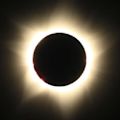Resultado de búsqueda
Hace 5 días · The solar eclipse of April 8, 2024, also known as the Great North American Eclipse, was a total solar eclipse visible across a band covering parts of North America, from Mexico to Canada and crossing the contiguous United States.
13 de jun. de 2024 · El eclipse lunar es un acontecimiento especial, ya que no ocurre todos los meses. A diferencia del eclipse solar, muchas personas pueden ver todos los eclipses lunares. Podrás ver el eclipse si vives en la mitad de la Tierra en la que es de noche mientras este se produce.
Hace 6 días · Total eclipse. A total eclipse occurs on average every 18 months [11] when the dark silhouette of the Moon completely obscures the bright light of the Sun, allowing the much fainter solar corona to be visible. During an eclipse, totality occurs only along a narrow track on the surface of Earth. [12] .
Hace 6 días · Hoy se conmemoran cinco años desde el extraordinario eclipse total de Sol que tuvo lugar el 2 de julio de 2019, un evento astronómico que dejó una profunda huella en la región de Coquimbo.
20 de jun. de 2024 · Watch NASA's coverage of the solar eclipse as it dashes through North America on April 8. The eclipse begins in the Pacific where it will cross into Mexico, cut through Texas and hit 15 states...
13 de jun. de 2024 · A solar eclipse happens when, at just the right moment, the Moon passes between the Sun and Earth. Sometimes the Moon only blocks part of the Sun’s light. This is called a partial solar eclipse. Other times, the Moon blocks all of the Sun’s light. This is called a total solar eclipse.
13 de jun. de 2024 · La corona, la atmósfera del Sol, es mucho más caliente que la superficie del Sol. ¡Los eclipses solares totales son una gran oportunidad para estudiar esta capa misteriosamente caliente! ¿Cómo se bloquea completamente el sol en un eclipse?

